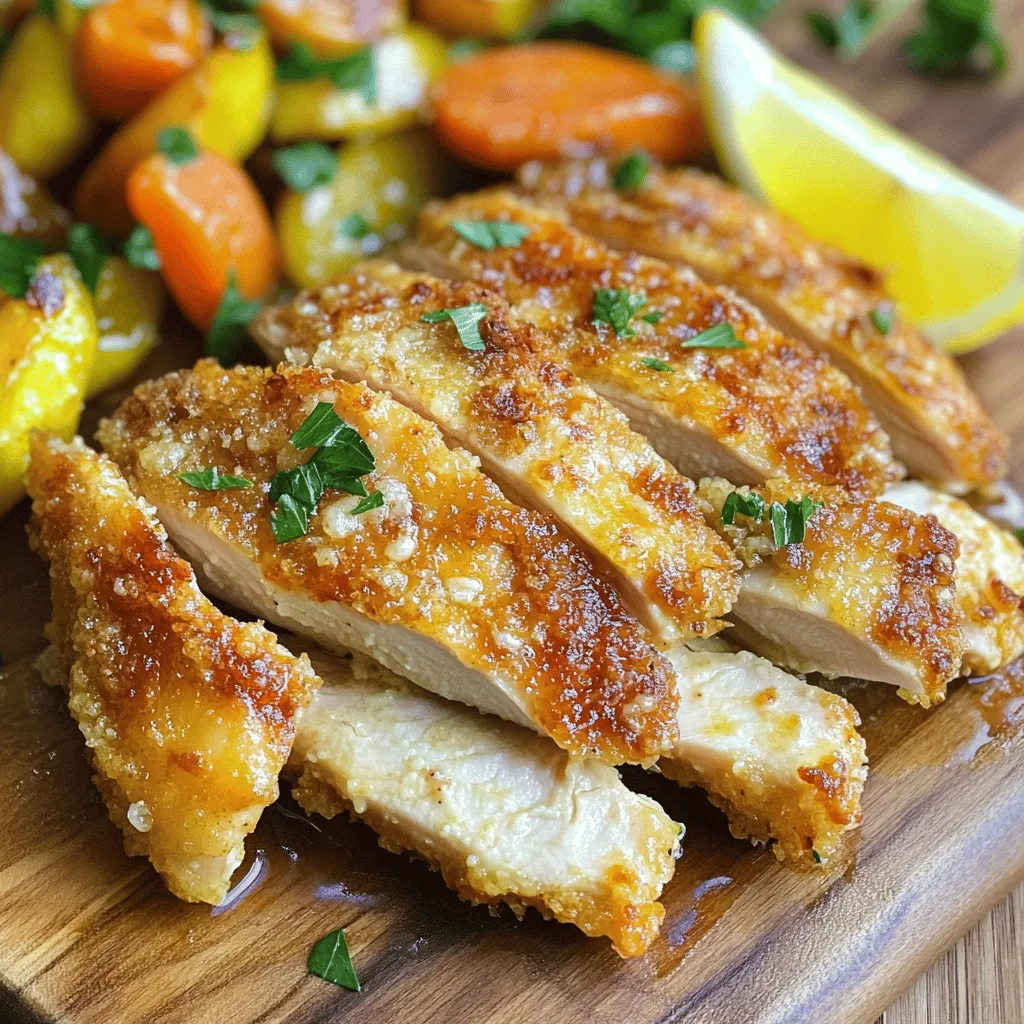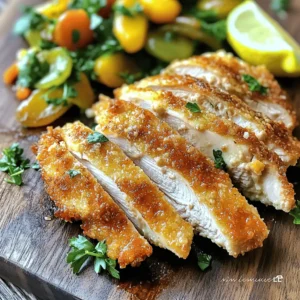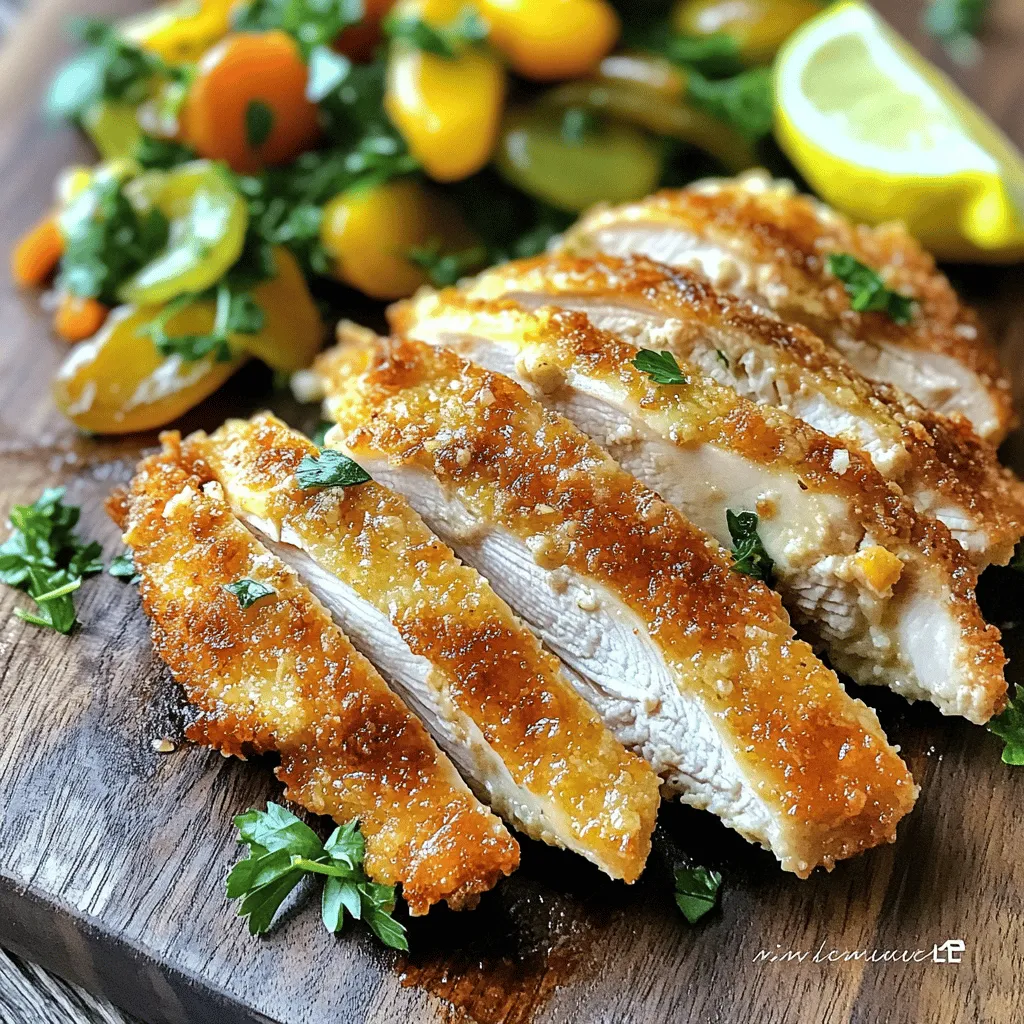If you crave delicious, tender chicken, you’re in the right place! My Melt in Your Mouth Chicken recipe promises a tasty meal with simple steps. You’ll find out how easy it is to use everyday ingredients that you might already have at home. Join me as I walk you through creating a dish that’s sure to impress friends and family alike. Let’s get cooking!
Ingredients
List of Main Ingredients
– 4 boneless, skinless chicken breasts
– 1 cup buttermilk
– 1 tablespoon garlic powder
– 1 tablespoon onion powder
– 1 teaspoon smoked paprika
– 1 teaspoon dried thyme
– 1 teaspoon salt
– ½ teaspoon black pepper
– 1 ½ cups all-purpose flour
– ½ cup grated Parmesan cheese
– 1 tablespoon fresh parsley, chopped (for garnish)
– ½ cup olive oil
Measurement Guide
You can easily change the ingredient amounts. For example, if you want to make more, just double every item. If you need to use less, cut each amount in half. For the buttermilk, you can use yogurt or milk with a little vinegar if you run out.
Recommended Tools
You will need a few kitchen tools for this recipe:
– Large mixing bowl
– Skillet for frying
– Tongs to handle the chicken
– Paper towels for draining oil
– Measuring cups and spoons for accuracy
These tools will help you prepare and cook the chicken well. Using the right tools makes cooking easier and more fun!
Step-by-Step Instructions
Marinating the Chicken
To start, gather a large bowl and the marinade ingredients. Combine 1 cup of buttermilk, 1 tablespoon of garlic powder, 1 tablespoon of onion powder, 1 teaspoon of smoked paprika, 1 teaspoon of dried thyme, 1 teaspoon of salt, and ½ teaspoon of black pepper. Whisk these together until smooth.
Now, add the 4 chicken breasts to the bowl. Make sure they are covered by the marinade. Cover the bowl and place it in the fridge. Let the chicken marinate for at least 2 hours. For the best taste and tenderness, marinate overnight. This step is key for juicy chicken.
Preparing the Coating
In another bowl, mix 1 ½ cups of all-purpose flour with ½ cup of grated Parmesan cheese. Stir well to combine. This mixture gives the chicken a great flavor and crispy texture.
For a perfect coating, ensure that every piece of chicken is well-covered. You can add spices to the flour for extra taste. Just make sure to keep the coating simple for a classic flavor.
Cooking the Chicken
Next, it’s time to heat the oil. In a large skillet, pour in ½ cup of olive oil. Turn the heat to medium. You want the oil to shimmer but not smoke. A good test is to drop a bit of the flour mixture in. If it sizzles, the oil is ready.
Carefully place the coated chicken in the hot oil. Cook each piece for about 5-7 minutes on each side. You want them to turn a nice golden brown. The chicken should reach an internal temperature of 165°F (75°C). If you have many pieces, cook them in batches. This helps them cook evenly.
Check out the full recipe for more details on serving and presentation.
Tips & Tricks
Achieving the Best Texture
To get that melt-in-your-mouth feel, you need to marinate well. The buttermilk tenderizes the chicken. Keep it in the marinade for at least two hours. For best results, marinate overnight.
Avoid these common mistakes to keep the chicken tender:
– Don’t skip the marination time.
– Don’t overcrowd the pan while cooking.
– Avoid cooking on too high heat.
Serving Suggestions
Pair your chicken with sides like mashed potatoes or green beans. A fresh salad also works great. For sauces, try a tangy lemon sauce or creamy garlic sauce.
To plate the dish, slice the chicken and arrange it nicely. Add a side of seasonal veggies and a lemon wedge for color. This makes your meal pop!
Recommended Cooking Techniques
You can try different methods like oven-baking or air-frying. Each method gives a unique texture. Baking keeps the chicken juicy, while air-frying adds crispness without much oil.
When using the oven, set it to 400°F. This will cook the chicken evenly. If you air-fry, keep the temperature at 375°F for the best results. Each method will make the chicken delicious in its own way.
For the full recipe, check out the section above.

Variations
Flavor Twist Ideas
You can easily change the taste of melt in your mouth chicken. Here are some fun ways:
– Herb and spice variations: Use fresh herbs like rosemary or basil. Try spices like cayenne for heat and cumin for depth.
– International flavor inspirations: Add Italian flair with oregano and sun-dried tomatoes. For an Asian twist, use soy sauce and ginger in the marinade.
Dietary Adjustments
Want a healthier version? You can make some simple changes:
– Gluten-free alternatives: Swap all-purpose flour with almond flour or a gluten-free blend.
– Dairy-free options: Replace buttermilk with almond milk or coconut milk mixed with lemon juice.
– Leaner protein: Use chicken thighs or turkey for a change. Both keep the dish juicy!
Portion and Serving Variations
You can adapt this recipe for any occasion:
– Larger gatherings: Double the recipe and use two pans to cook at once. This way, everyone gets their fill.
– Mini portions: Cut chicken into bite-sized pieces for appetizers. Serve with toothpicks and a tasty dip for easy eating.
Feel free to explore these variations to make the dish your own. Check out the Full Recipe for all the details!
Storage Info
Proper Storage Techniques
To store leftover chicken, let it cool first. Place it in an airtight container. This keeps the chicken fresh and safe. You can store it in the fridge for up to four days. For longer shelf life, freezing is a great option. Wrap the chicken tightly in plastic wrap or foil, then place it in a freezer bag. This helps prevent freezer burn and keeps it tasty for about four months.
Reheating Guidelines
The best methods to reheat chicken include using an oven or stovetop. For the oven, preheat it to 350°F (175°C). Place the chicken on a baking sheet and cover it with foil. This keeps the chicken moist. Heat for about 20 minutes or until warm. On the stovetop, use a skillet over low heat. Add a splash of broth or water to help keep the chicken juicy. Heat until warmed through, flipping occasionally.
Shelf Life
In the fridge, chicken stays fresh for about four days. After that, it may spoil. Signs of spoilage include a foul smell or a slimy texture. If you notice any of these signs, it’s best to discard the chicken. Always trust your senses; when in doubt, throw it out. Proper storage and quick inspection help you enjoy melt in your mouth chicken safely!
FAQs
Common Cooking Questions
What is the ideal internal temperature for chicken?
The perfect internal temperature for chicken is 165°F (75°C). This ensures the chicken is safe and fully cooked. Use a meat thermometer to check the temperature in the thickest part of the meat. Cooking chicken to this temperature keeps it juicy and safe to eat.
How long can marinated chicken be stored in the fridge?
You can store marinated chicken in the fridge for up to 2 days. If you marinate it longer, the chicken may become too soft. Always cover the chicken well to prevent any odors from other foods in the fridge.
Ingredient Questions
Can I use frozen chicken for this recipe?
Yes, you can use frozen chicken. Just remember to thaw it first. Place the chicken in the fridge a day before cooking. This keeps the meat safe and ready for marinating. Never cook chicken from frozen; it may not cook evenly.
What can I substitute for buttermilk?
You can make a buttermilk substitute easily. Mix 1 cup of regular milk with 1 tablespoon of lemon juice or vinegar. Let it sit for 5-10 minutes. This will mimic the tangy flavor of buttermilk in your recipe.
Recipe-Specific Queries
How to make the chicken more flavorful?
To boost flavor, add herbs and spices to the marinade. Try fresh herbs like rosemary or thyme. You can also add a splash of hot sauce for some heat. Letting the chicken marinate overnight really helps the flavors soak in.
Can I scale the recipe for meal prep?
Yes, you can easily scale this recipe. Just double or triple the ingredients based on how many servings you need. This makes it perfect for meal prep or feeding a crowd. Store the cooked chicken in airtight containers for easy meals throughout the week.
For the full recipe, check out the detailed steps above!
In this blog post, I covered key ingredients, tools, and techniques for cooking chicken. I explained how to marinate, coat, and cook the chicken for the best taste. Remember to store leftovers properly and know when they spoil. With these tips, you can create a tasty meal every time. Experiment with flavors and methods to find what you love. Cooking chicken can be fun and rewarding. Enjoy your time in the kitchen!

